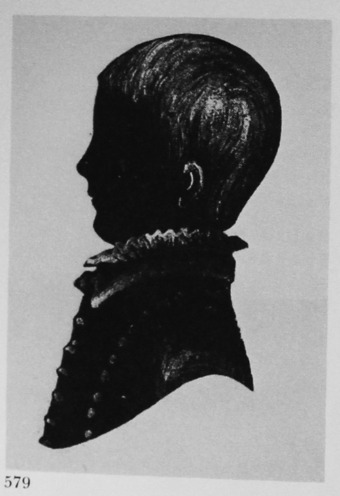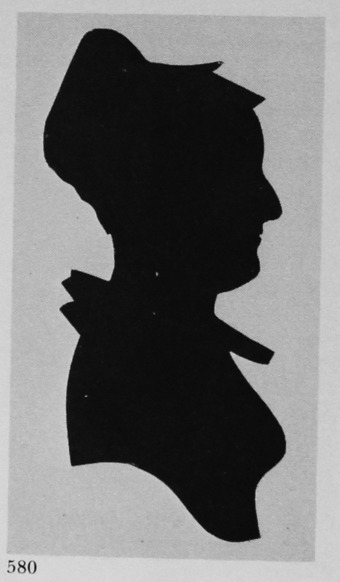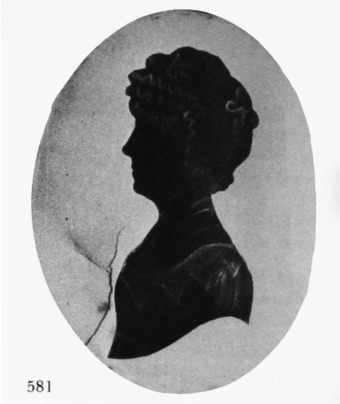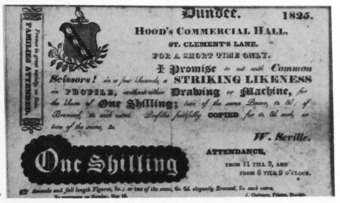Seville, W. and Son (McKechnie Section 1)
See also Sections Two and Six
Recorded by Jackson (The History of Silhouettes), also by Woodiwiss (British Silhouettes) and Mayne, all of whom refer to him as F. W. Seville. Trade labels and handbills give either the one initial 'W.' or simply the prefix 'Mr'. A recently discovered handbill, printed and used in Shrewsbury in 1845 and issued by 'Messrs. Seville & Son', suggests that the three writers may have been referring to W. Seville's son. whose initials may have been F. W.
586
Seville used the coat-of-arms of the Savile, or Saville family on his handbills, but the significance of this is hard to determine. Seville may have been a member of the Saville family who altered his name for professional purposes. Alternatively, he may have been unconnected with the family, using the similarity of the names as a pretext for making use of the coat-of-arms (a practice which, as Mr Gordon Roe has pointed out to me, was fairly common in Seville's day).
We do know from the Shrewsbury handbill that Seville hailed from Manchester, though this cannot be confirmed from the city records. We also know from this handbill that Seville (and his son) offered a great variety of work, including portrait miniatures (probably in full- or three-quarter face) on ivory. Foskett, however, does not refer to either of the Sevilles.
W. Seville probably began work as a silhouette artist, a year or two before 1820, in Manchester. Woodiwiss notes an address at Market Street in the city, but we cannot be certain that he was not confusing this with the street of the same name in Lancaster, where Seville worked later. Jackson records an address at 'Mrs Strong's, near the Post Office, North Shields', where Seville was working in April 1820. It seems that by this date Seville had begun to travel as an itinerant artist, and although recently a number of new dates
and centres of work have come to light, it may be that the artist was still based in Manchester. His tour eventually not only covered the north of England, but extended to Scotland and Ireland (see below) and Wales (Jackson records a visit to Caernarvon). He may also have worked in East Anglia (see below).
On 29 April 1824 Seville was advertising at Newcastle-on-Tyne. Here his address was at 'MrDixon's Long Room, at the White Hart Inn in the Old Flesh Market' (an address erroneously recorded by Jackson as that of John Dixon: see Section Two). Prices given in the Newcastle advertisement were:
One Black Shade for Is.
Two Black Shades for Is. 6d.
These, 'bronzed', Is. extra.
Full-length: 5s.
Two full-lengths for 6s. 6d.
Bronzed: 2s. extra
Dogs: 3s. 6d.
In the same year Seville was in Lancaster. Jackson illustrates the handbill which he used. It is headed by the Savile coat-of-arms and the words 'Lancaster, 1824'. The address is 'at a large room adjoining the Merchant's Coffee Room, Market Street'. The remainder of the text is as follows:
Striking Likenesses cut with Common Scissors in a few seconds without Drawing or Machine, or any other aid, but by a mere glance of the EYE!! by Mr. SEVILLE. Full-length figures, Animals, &c, &c., cut in any attitude. Profiles faithfully copied. Plain Bust Is. Two of the same Person Is. 6d. Elegantly bronzed Is. each extra. Frames in great variety on sale. Attendance from 11 till I, from 3 till 5, and from 6 till 9 o'clock. Families attended. ONE SHILLING. Full length 5s., or two of the same 6s. 6d.
Another handbill (illustrated) tells Us that Seville was working in Dundee from 16 May 1825.
585
Seville's price for portraits of animals had now risen to 5s. He probably spent most, or all, of this year in Scotland, since he is hardly likely to have travelled as far north as Dundee without also visiting Edinburgh and Glasgow at least.
Another trade label has been seen, bearing a profile taken apparently c. 1826-30, which includes beneath Seville's name that of a Mr Stannard, who was apparently working with Seville before the latter's son was old enough to enter the business. The wording of the label suggests that Stannard was producing coloured work for Seville. Foskett lists one artist of this name, Joseph Stannard (1797-1830; see Section Six), who was born and died in Norwich. He is known to have painted marine and river subjects, portraits and miniatures, and to have executed etchings. Some of his miniatures on card (some of them unfinished) are in Yarmouth Museum. If indeed it was this artist who towards the end of his not very long life worked for or with Seville, then Seville would surely have been based in East Anglia for a period in the late 1820s.
A full-length portrait of a Miss Robertson (seated, with a harp), drawn entirely in pencil, has recently come to light (it is owned by Mr and Mrs J. H. Gutteridge). This is dated August 1830, and inscribed as having been taken in Castletown, Dublin. We know, therefore, that Seville was in Ireland in 1830, but we have no information about his whereabouts during the rest of the decade.
I have seen only one dated silhouette (illustrated) from these years; it was taken in 1832, but the place is not given.
581
Seville's son may have begun to work with his father before the end of the decade. It is certain that W. Seville was in Ireland, probably with his son, in 1842. There is in my collection a silhouette, taken on 1 August 1842, which is painted in a much finer style than most surviving examples signed with Seville's name.
584
In fact, it may be partly the work of Seville's son, even though it is inscribed, in a cursive hand, 'Cut with scissors by W. Seville'. Possibly W. Seville cut the profile, and his son (perhaps more accomplished with the brush) may have executed the pencilling in gold.
In the Kilner collection there is a silhouette, taken in January 1845 in Shrewbury, which shows the coarse type of gold work which suggests W. Seville's hand.
By 1845, as the handbill used in Shrewsbury in that year states, a wide variety of work was being offered by the Sevilles. It may have been when the younger Seville joined the business that its scope was extended to include coloured work and miniatures on ivory, although other artists may have been employed for this work.
For how long after 1845 the Sevilles continued to prosper we do not know; it seems likely that they were among the many artists whose output was affected by the advent of photography.
In considering the Sevilles' work, we have to deal with that of the elder Seville for the period c. 1818-c. 1845. He appears to have been a good freehand cutter, although his work in this field falls short of the brilliance of Edouart's. Some of his cut profiles are bronzed. The two illustrated examples from the 1830s are typical of Seville's work of this type.
581, 582
The basic outlines of these bust-length profiles are plainly cut, and although they may have been good likenesses, the bronzed detail is roughly shown. Bust-line terminations follow a simple convexity-concavity line, extending to some length in front. The unembellished cut black bust-length profiles were very cheap for the period; I have seen a number of these, and there are several in the Fox-Smith collection.
Most of the extant silhouettes dating from the 1840s are in full-length, and their quality is much more variable. I think that those embellished with fine pencilling are probably the work of the younger Seville. It is clear, however, that the Sevilles executed a great deal of plain black full-length work throughout their careers: silhouettes of 'infants in their Mother's or Nurses' Arms', 'Children at their favourite pursuits or studies', and of 'Officers in Uniform' are all specifically offered.
It is possible that the younger Seville did not cut profiles at all, but with his skill with the brush, was able to embellish with gold (better than his father would have done) profiles cut by his father.
Bust-length silhouettes taken before and during the 1830s have been seen in papiermache frames. Later examples both bust-length and full-length, have survived in rosewood frames with gilt surrounds, or in frames veneered in mahogany. Maple frames were sometimes used during the 1840s.
Eight trade labels are known. No prices are given on any of them, and their chronological order can only be deduced from the costume of the sitters on the silhouettes on which examples of the different labels have been seen.
Trade Label No. I (illustrated) is a small label printed on orange red paper: it was used c. 1815.
879.
Trade Label No. 2 is printed on bright yellow paper.
587
The artist refers to himself as 'Mr. W. Seville'; otherwise the wording is the same as of No. 1. This label was used during the early 1820s. There is an example on a black bust-length silhouette in the Fox- Smith collection.
There are examples of Nos. 3 and 4 also on silhouettes in this collection. Trade Label No. 3 has the same wording as No. 2, but is printed on bright green paper. It was used during the early or mid-1820s.
Trade Label No. 4 has the same wording as Nos. 2 and 3, but is printed on pink paper. It has the name `Mr. Seville' (without an initial), and measures 3/8 x 11/4 in. It was used during the late 1820s and early 1830s.
Trade Label No. 5, like No. 4, is printed on pink paper, but is larger. It dates from, perhaps, c. 1826-30 and reads:
Cut with Common Scissors by
Mr. W. Seville
Miniatures on ivory, and coloured Likenesses in a variety of Styles by
Mr. Stannard
Trade Label No. 6, a label noted by Jackson, is printed on brown paper. The date at which it was used is unknown.
Trade Label No. 7, printed on blue-green paper, has the same wording as Nos. 2, 3, and 4. It was certainly used in 1832, the date of a silhouette (illustrated) which bears it.
581
Trade Label No. 8 (illustrated) is an embossed mark, reading 'W. Seville Artist' and known to have been used in 1842.
588
Handwritten inscriptions are known, but I have seen them only on silhouettes dating from the 1840s.
Ills. 579-589

Unknown boy
Cut silhouette, embellished with gold
? c. 1819
4 x 3in./102 x 77mm.
Trade Label no. 1
Crown Copyright. Victoria and Albert Museum, No. E256-1942

Unknown woman
Cut silhouette
Early 1820s
4 x 3in./102 x 77mm.
Crown Copyright. Victoria and Albert Museum, No. E260-1942

Mrs Dunlop
Cut silhouette, embellished with gold
1832
3¼ x 2¾in./83 x 70mm.
Trade Label No. 7
Frame: papier mâché
Author’s collection

Unknown man
Cut silhouette, embellished with gold
Mid-1830s
3¼ x 2¾in./83 x 70mm.
Trade Label No. 4
Frame: papier mâché, without hanger
W. E. Fox-Smith collection

Mrs Stevenson
Cut silhouette, pencilled in gold
January 1845
10 x 7in./254 x 178mm.
Frame: maple
The gold pencilling is coarse in comparison with that (probably executed by the artist’s son) on the silhouette shown in 584. Inscribed on the reverse, ‘Taken at Shrewsbury, January, 1845, by W. Seville’.
R. Kilner collection

Miss Peggy Burnside
Cut silhouette, pencilled in gold
1 August 1842
8 x 5¾in./204 x 147mm.
Embossed stamp
Frame: rosewood
The pencilling in gold, of finer quality than that seen on work done by W. Seville alone, is almost certainly from the hand of his son. W. Seville’s embossed stamp is near the legs of the chair. Inscribed on the reverse, ‘Cut with scissors by W. Seville, Aughnacloy, 1st August, 1842’.
Author’s collection

Handbill of W. Seville, headed by the Saville coat-of-arms, stating that the artist will start work in Dundee on 16 May 1825 at Hood’s Commercial Hall.

Handbill of W. Seville and his son, printed and used in Shrewsbury, 1845.
Author’s collection

Trade label No. 1 of W. Seville, from the silhouette of a boy (see 579), probably taken in c. 1819. Printed on orange paper.
Crown Copyright. Victoria and Albert Museum, No. E256-1942

Trade Label No. 8 (an embossed stamp) of W. Seville, on the corner of the card bearing a silhouette; used in 1842. From the reverse of a full-length silhouette (584).
Author’s collection

Handwritten inscription of W. Seville, from the reverse of a full-length silhouette (584).
Author’s collection
